[Updated 2017]
Living in Singapore, you get ready access to a huge variety of cuisines: Japanese, Chinese, Thai, Indian, Italian, French, Indonesian – just to name a few, in addition to local Singaporean food.
However, one cuisine that we don’t get much exposure to is South American cuisine. While there are some similarities with Indian food, Ecuadorean food is definitely very new to me and deserves its own post!
Breakfast (el desayuno)
This is typically a continental breakfast (e.g. coffee/tea, juice, eggs, bread with cheese). You can find restaurants selling these in Quito for under $2.
My host family serves more creative breakfasts though. Here’s one of my recent breakfasts:
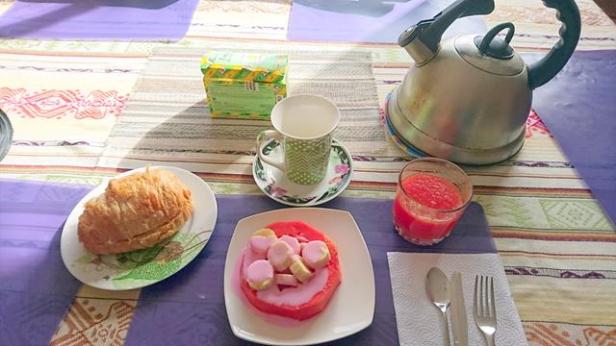
There’s always juice, tea (in this case anise tea), fruits and bread with some meat and cheese or egg. A very healthy and balanced meal! There’s usually banana, papaya and sometimes pineapple (that’s a papaya ring above).
The first day they provided some ground coffee as well but then realised that I didn’t take it.
(Side note: I haven’t been this caffeine-free in a long time and frankly, I’m surprised that I can still function more or less normally without it!)
Lunch (el almuerzo)
Again, the almuerzos here follow a basic pattern: juice, soup and rice-based dish. You can eat something else – a sandwich, or a pizza, perhaps – but it’s not considered an almuerzo.
E.g.: orange juice, soup with chicken feet, rice and bits of carrot, and rice with fries, beans and roast chicken ($2.50). The beans remind me of dhal.
I was astonished to find that eating chicken feet is not just a Chinese thing! In Ecuador they often put chicken parts that you don’t normally eat in the soup – e.g. the neck, feet and even the head. Eating chicken feet was a nice feeling of familiarity and home.
Other examples:
Juice, soup with fish and arroz relleno (fried rice with sausage, peas, carrots and a bit of banana).
Juice, potato soup with veggies, and rice with pork chop and beans.
Dinner (la merienda)
An example of the language differences between Spain and Ecuador – I learnt that dinner was la cena and una merienda is a snack, but here dinner is la merienda. La cena seems to mean something like a post-dinner snack or a special feast.
The traditional dinner is similar to lunch, but my host family typically just has sandwiches and coffee. They cook hot food for me, though. So far, I’ve had:
- spaghetti
- arroz relleno – they chose this because it’s similar to Chinese food, which I’m used to. How thoughtful! (There are a number of Chinese restaurants here selling chaulafan which seems to be chao fan or fried rice, but I haven’t tried them. They tell me there are many more in Peru.)
- rice with chicken and caramelised banana (orito – smaller than a plantain and extremely sweet!)
- rice with chicken, avocados, lettuce and corn on the cob
Snacks (bocadillos/bocaditos)
In Spain, a bocadillo is a baguette-type sandwich. Here, a sandwich is sánduche and bocadillos or bocaditos are snacks. Also, here una tapa means a lid, not food! Confused yet?
At Yanapuma Spanish School, they have a weekly tasting of bocaditos. Each student is assigned one bocadito to bring and share, and we’re also expected to introduce it to the others – what it’s made of, how it’s made, etc.
I got la humita – a very popular Latin American snack made from ground young corn (choclo), onions, eggs, butter, baking powder, salt/sugar and cheese (the ingredients may vary regionally). Mature corn (where the kernels are tough) is called maíz and it doesn’t work for this dish.
It’s prepared by wrapping the dough in a corn (specifically choclo) leaf and steaming for 30 minutes. It’s so popular that there is a special pot for steaming the humitas – it’s called a tamalera.
It can be either sweet or savoury, although the savoury version is more common. The one on the left above is sweet – you can tell by the black dots of anise. It’s not too sweet though. The one on the right is savoury.
These cost $0.80 each!
I also learnt to make them during my time in Intag and they’re surprisingly easy to make! The hard part is grinding the choclo, but you can also just blitz them in a food processor or even a blender (which I did when I tried to recreate them back home in Singapore. You end up with more chunky bits of corn, but it still tastes legit).

The other bocaditos we had:
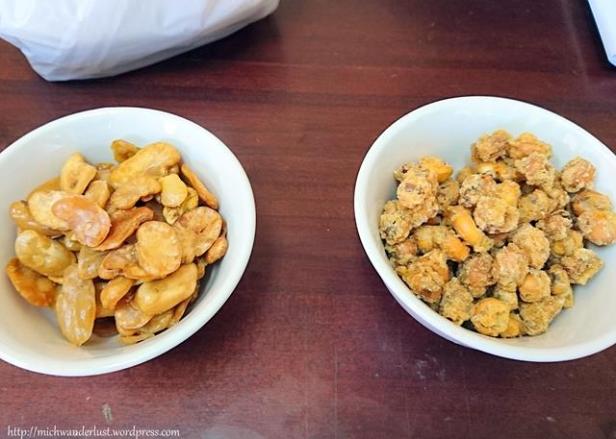
Left: habas (broad beans). Right: caca de perro (corn – maíz – coated in salt and panela sugar).
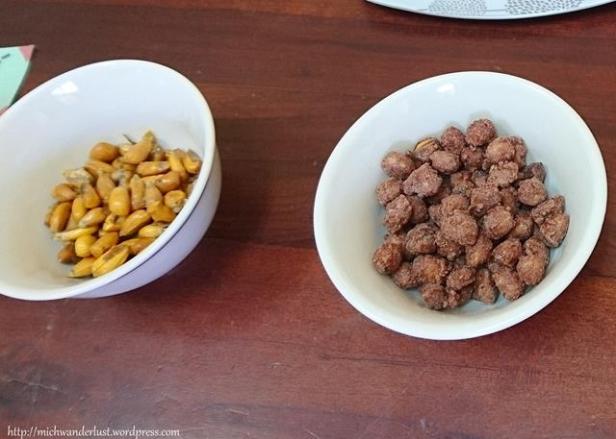
Left: tostado (maíz toasted with salt). Right: maní dulce (peanut coated with sugar. Sometimes you can also find it coated with sesame)
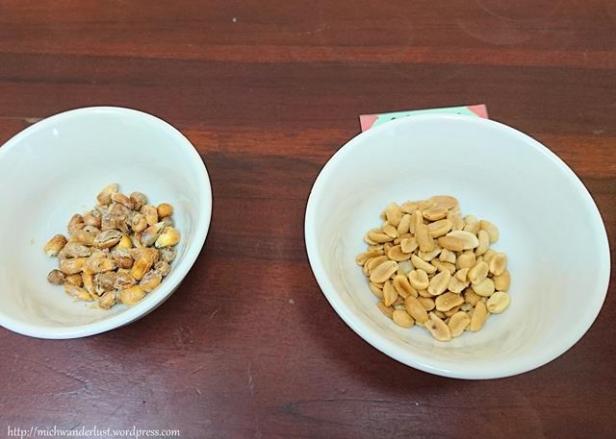
Left: chulpi (very similar to tostado but a smaller type of corn). Right: salted peanuts.
Later on, I bought chochos (which look like some kind of bean but apparently are legumes). They’re full of vitamins and protein and can be served with ceviche.
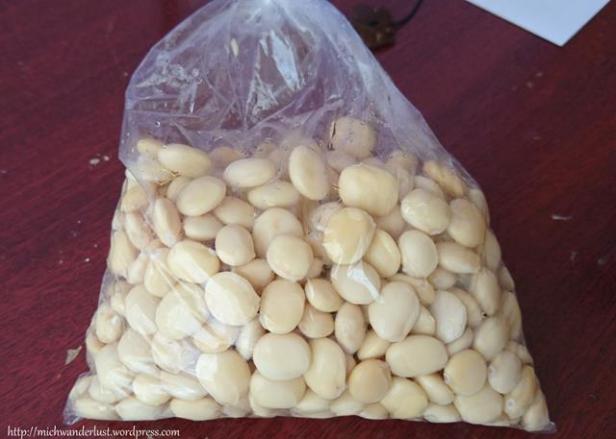
This bag (I bought it full but ate quite a bit before taking the photo) cost $1. It has a very subtle taste that’s slightly bitter.
A quesadilla here is nothing like the Mexican version. It’s a pentagonal bun made of cornflour, butter, eggs, cheese and sugar. It’s a little too cheesy for my taste (I’m not a big fan of cheese).

Not forgetting to mention the very popular empanadas!
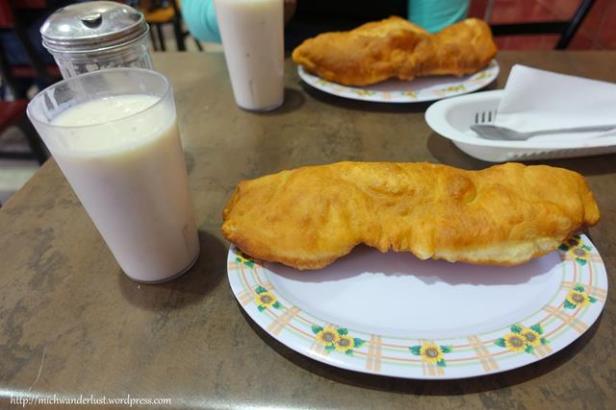
This is a variety called empanada de viento (“wind” – because the dough is left to rest for a bit and rise). The taste is astoundingly similar to hum chin peng, one of my favourite Singaporean snacks. However, this empanada isn’t eaten plain like hum chin peng is. You can choose fillings such as cheese, chicken or beef.
The drink is called morocho, a type of corn that’s very tough. The morocho is chopped up into small bits and they add milk, cinnamon and other spices. Sometimes they add raisins too.
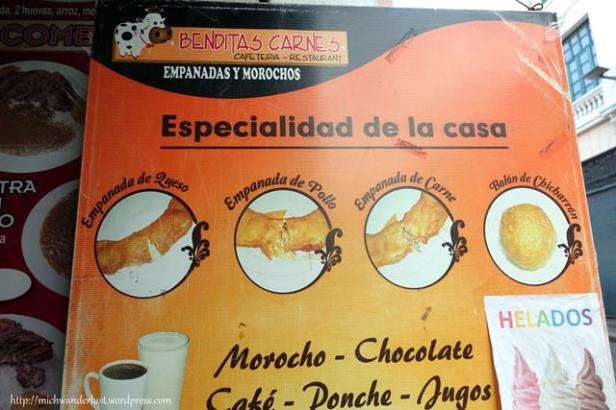
We ate at this restaurant that specialises in empanadas and morochos. You can choose a variety of drinks to go along with it, not just morocho.
It’s located near La Iglesia de El Carmen Alto, a couple of minutes’ walk from La Ronda.
I also tried bizcochos – a type of biscuit made with flour, butter, eggs and anise.
Apart from empanadas, my personal favourites are quimbolitos and humitas.


Quimbolitos are kind of like sponge cakes in texture. They aren’t made of terribly exotic ingredients: flour, egg, sugar, salt, butter, etc. – but their distinctive feature is that they’re wrapped in achira leaves and steamed. You can also wrap them in banana leaves (I tried this at home in Singapore.) You can also put anything you want in them to jazz them up! They’re good with raisins, cocoa powder, pumpkin bits – be creative!
There are many other snacks which I’ve learnt about but haven’t tried yet. There will be plenty of opportunities, though. Looking forward to sampling more Ecuadorean snacks!
For a far more authoritative list of Ecuadorean street food/snacks, check out http://laylita.com/travel/270/15-ecuadorian-street-foods-must-try/.
What’s your favourite type of street food?
This post is part of The Weekly Postcard hosted by Travel Notes & Beyond, A Hole in My Shoe, Toddlers on Tour, Two Traveling Texans and Arnie and Jo are on the Go – check out what’s going on elsewhere!
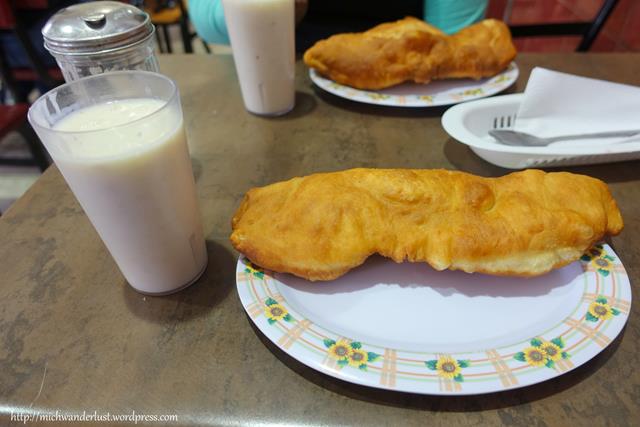









I love South American cuisine, especially the empanadas, although they are so fattening.
They have a lot of fried foods (which I love), but they are very high in calories. Bizcochos sound great, although I never tried them.
LikeLiked by 1 person
Yes, it’s definitely not the most healthy! There’s a distinct lack of vegetables as well, but luckily my host family has been giving me lots of fruits. Thanks for stopping by, Anda 🙂
LikeLike
I loved the food when I was in Ecuador! I know one of their specialties is guinea pigs! I didn’t get up the courage to try it though. Thanks for linking up with #TheWeeklyPostcard!
LikeLiked by 1 person
Thanks for your comment, Anisa 🙂 Yes, they do eat guinea pigs! I haven’t had the opportunity to eat it though – and honestly I probably wouldn’t if I had a choice.
LikeLiked by 1 person
😀 as an ecuadorean I can tell you you are not missing on anything haha they taste funny and you kinda feel bad eating them because they are such cuties!
LikeLiked by 1 person
Thanks Maria, that’s good to know 😉
LikeLiked by 1 person
I used to live near a great place for empanadas – yum! I haven’t been to Ecuador but Laurence spent a couple months there and talks about how cheap and filling the food was during his time there. Look forward to going there.
LikeLiked by 1 person
The food is definitely cheap and filling! In fact I wish it came in smaller portions because I can’t ever finish my meals and I hate wasting food. Hope you get to visit sometime, Jessica 🙂
LikeLike
I’m not very familiar with Ecuadorean food. The empanadas look really yummy, and las humitas remind me of Mexican tamales.
LikeLiked by 1 person
Yeah I think they’re really similar!
LikeLike
Yummy! Unlike you, I am a big fan of cheese, but as a vegetarian I can’t see myself sitting down to a chicken feet soup! What a great experience, though. 🙂
LikeLiked by 1 person
Thanks, Kirstin! 🙂
LikeLike
Yummm, this makes me miss Ecuadorean food so much! Have you tried ceviche yet?
LikeLiked by 1 person
Nope not yet! I’ve only eaten seafood twice or thrice in almost two months here in the Sierra
LikeLike
You have to try ceviche before you leave Ecuador! Some of the best is made in la Costa where the seafood is more fresh 🙂
LikeLiked by 1 person
Thanks, Jen! Yup I think I’ll try it when I get to the coast 🙂
LikeLiked by 1 person
Michelle, thank you so much for your food tutorial. My hubby and I are headed off for Ecuador in a few days and I am so excited to give the local dishes a try. The empanadas sound yummy.
LikeLiked by 1 person
Thanks, Joanne! Are you still in Ecuador? Hope you’re enjoying (or enjoyed) it as much as I am!
LikeLike
Michelle we have 11 days remaining. Total time here almost three weeks.
LikeLiked by 1 person
Oh how I miss these foooood! I can’t even tell you. I am so happy you liked our food 🙂
LikeLiked by 1 person
Ecuadorean food is really delicious! 🙂
LikeLike
Great post Michelle!!! I can’t wait to try Ecuadorean food on my upcoming trip!! Thanks for sharing!
LikeLiked by 1 person
Thanks and hope you have a wonderful time in Ecuador!
LikeLiked by 1 person